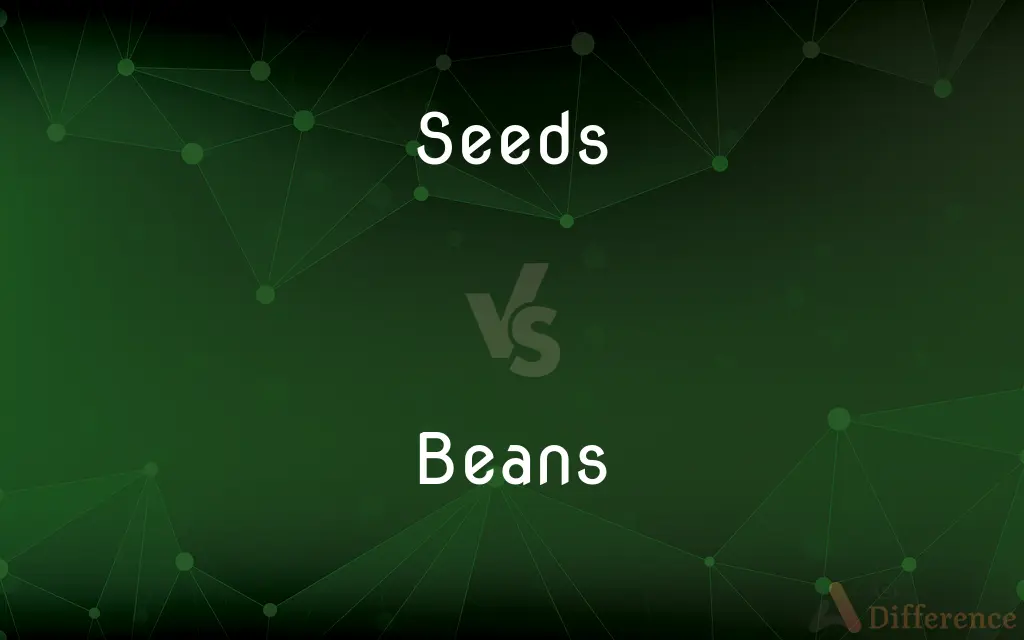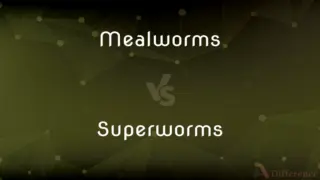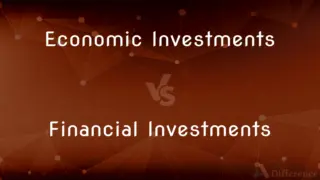Seeds vs. Beans — What's the Difference?
By Tayyaba Rehman & Urooj Arif — Published on March 1, 2024
Seeds are embryonic plants encased in a protective outer covering, with a wide variety of types including beans, which are a type of legume seed specifically adapted for consumption and planting.

Difference Between Seeds and Beans
Table of Contents
ADVERTISEMENT
Key Differences
Seeds are the reproductive part of a plant, capable of developing into another plant. They come in various forms, serving not just as the basis for new plants but also as a source of food, oils, and spices. Beans, on the other hand, are a specific category of seeds belonging to the legume family, characterized by their high protein and fiber content, making them a staple in diets worldwide.
All beans are seeds, but not all seeds are beans. This distinction is crucial in understanding their role in agriculture and diet. Seeds encompass a broader category including fruits, nuts, grains, and beans, used for a myriad of purposes beyond human consumption, such as producing oils, feeding livestock, and even in industrial applications. Beans specifically refer to the edible seeds of plants in the legume family, which are cultivated primarily for food.
The nutritional profile of beans sets them apart from other seeds. Beans are particularly rich in proteins, making them an essential part of vegetarian and vegan diets as a meat substitute. While other seeds, such as sunflower or pumpkin seeds, are also nutritious, offering healthy fats, vitamins, and minerals, beans provide a unique combination of nutrients beneficial for human health.
Cultivation practices for beans also differ from other seeds. Beans, being legumes, have a symbiotic relationship with bacteria in the soil that helps them fix nitrogen, enriching the soil in which they grow. This characteristic makes them valuable in crop rotation and sustainable farming practices. In contrast, other seeds might require different cultivation conditions and may not offer the same environmental benefits.
The versatility of beans in culinary uses is notable compared to other seeds. While many seeds are used in cooking and baking, beans are a staple ingredient in a variety of dishes around the world, from soups and stews to salads and main courses. Their ability to absorb flavors and provide a satisfying texture makes them a preferred ingredient in diverse cuisines.
ADVERTISEMENT
Comparison Chart
Definition
Embryonic plants encased in a protective covering.
A type of legume seed adapted for consumption and planting.
Types
Includes fruits, nuts, grains, and legumes.
Includes various species like kidney, black, and pinto.
Nutritional Content
Varies widely; some are high in fats, others in minerals.
High in protein and fiber, essential for diets.
Cultivation
Diverse methods depending on the plant type.
Often involves crop rotation due to nitrogen-fixing ability.
Uses
Food, oils, spices, livestock feed, and more.
Primarily used for human consumption.
Compare with Definitions
Seeds
The unit of reproduction of a flowering plant, capable of developing into another such plant.
She planted sunflower seeds in her garden for the birds.
Beans
Edible seeds of plants in the legume family, rich in protein.
She added black beans to the salad for extra protein.
Seeds
A source of nutrition; some seeds are rich in vitamins and minerals.
Pumpkin seeds are a good source of magnesium.
Beans
Can be dried, stored, and cooked in various ways.
He soaked the beans overnight before cooking them.
Seeds
Often used to extract oils due to their high oil content.
Flax seeds are pressed to produce linseed oil.
Beans
A staple food in many cultures around the world.
Rice and beans form a complete protein meal.
Seeds
Can be used in various culinary applications, including baking.
He sprinkled sesame seeds on the bread before baking.
Beans
Beneficial for soil health due to their nitrogen-fixing ability.
Farmers rotate crops with beans to enrich the soil.
Seeds
Important for agriculture and ecosystem biodiversity.
Native plant seeds are vital for restoring habitats.
Beans
Used in both savory and sweet dishes, showcasing their versatility.
Red beans are used to make a sweet paste for desserts in Asian cuisine.
Seeds
A small dry fruit, spore, or other propagative plant part.
Beans
Any of several related plants or their seeds or pods, such as the adzuki bean, broad bean, or soybean.
Seeds
Set aside for planting a new crop
Seed corn.
Seed potatoes.
Beans
Any of various twining herbs of the genus Phaseolus in the pea family, native to the Americas, having leaves with three leaflets and variously colored flowers, and widely cultivated for their edible pods and seeds.
Seeds
To plant (a crop, for example) as seeds in soil.
Beans
A seed or pod of any of these plants.
Seeds
To sow seed.
Beans
Any of various other plants or their seeds or fruits, especially those suggestive of beans such as the coffee bean or vanilla bean.
Seeds
Plural of seed
Common Curiosities
Can all seeds be eaten?
Not all seeds are edible for humans; some are toxic, while others are used for different purposes like planting or oil extraction.
What is a seed?
A seed is the reproductive unit of a plant, capable of developing into a new plant.
Why are beans considered healthy?
Beans are high in protein, fiber, vitamins, and minerals, making them an excellent part of a balanced diet.
How do beans benefit agriculture?
Beans enrich the soil with nitrogen, improving soil health and aiding in crop rotation practices.
What makes beans different from other seeds?
Beans are specifically adapted for consumption and have unique nutritional profiles and agricultural benefits.
How do cultivation practices for beans and other seeds differ?
Beans, being legumes, have nitrogen-fixing abilities, which is beneficial for soil health, unlike some other seeds.
What are beans?
Beans are a type of edible seed from the legume family, known for their protein content.
Are beans good for vegetarians?
Yes, beans are an excellent protein source for vegetarians and vegans.
Do beans require special preparation before eating?
Many beans need to be soaked and cooked to eliminate toxins and improve digestibility.
Are there different types of beans?
Yes, there are many types of beans, including kidney beans, black beans, pinto beans, and more, each with unique flavors and uses.
Can seeds be used for purposes other than food?
Yes, seeds are used to produce oils, spices, and for planting to grow new plants.
Can eating beans have any side effects?
Some people may experience gastrointestinal discomfort due to the high fiber content in beans.
Why are beans a staple in many diets around the world?
Beans are versatile, nutritious, and can be a cost-effective source of protein, making them a staple in various cuisines.
How long can dried beans be stored?
Dried beans can be stored for years if kept in a cool, dry place, although they may require longer cooking times as they age.
What's the environmental impact of growing beans?
Growing beans can have a positive environmental impact by improving soil health through nitrogen fixation and reducing the need for chemical fertilizers.
Share Your Discovery

Previous Comparison
Mealworms vs. Superworms
Next Comparison
Economic Investments vs. Financial InvestmentsAuthor Spotlight
Written by
Tayyaba RehmanTayyaba Rehman is a distinguished writer, currently serving as a primary contributor to askdifference.com. As a researcher in semantics and etymology, Tayyaba's passion for the complexity of languages and their distinctions has found a perfect home on the platform. Tayyaba delves into the intricacies of language, distinguishing between commonly confused words and phrases, thereby providing clarity for readers worldwide.
Co-written by
Urooj ArifUrooj is a skilled content writer at Ask Difference, known for her exceptional ability to simplify complex topics into engaging and informative content. With a passion for research and a flair for clear, concise writing, she consistently delivers articles that resonate with our diverse audience.
















































